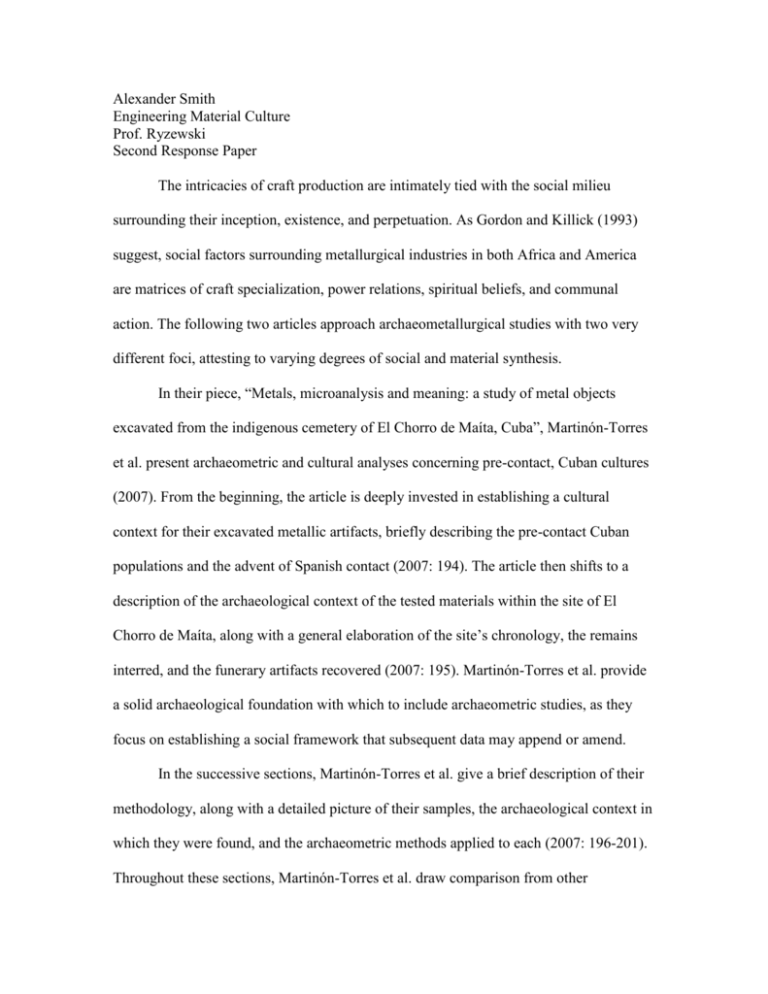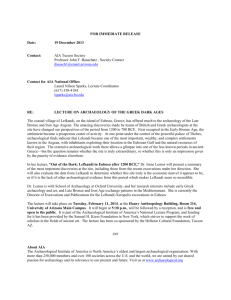Alexander Smith
advertisement

Alexander Smith Engineering Material Culture Prof. Ryzewski Second Response Paper The intricacies of craft production are intimately tied with the social milieu surrounding their inception, existence, and perpetuation. As Gordon and Killick (1993) suggest, social factors surrounding metallurgical industries in both Africa and America are matrices of craft specialization, power relations, spiritual beliefs, and communal action. The following two articles approach archaeometallurgical studies with two very different foci, attesting to varying degrees of social and material synthesis. In their piece, “Metals, microanalysis and meaning: a study of metal objects excavated from the indigenous cemetery of El Chorro de Maíta, Cuba”, Martinón-Torres et al. present archaeometric and cultural analyses concerning pre-contact, Cuban cultures (2007). From the beginning, the article is deeply invested in establishing a cultural context for their excavated metallic artifacts, briefly describing the pre-contact Cuban populations and the advent of Spanish contact (2007: 194). The article then shifts to a description of the archaeological context of the tested materials within the site of El Chorro de Maíta, along with a general elaboration of the site’s chronology, the remains interred, and the funerary artifacts recovered (2007: 195). Martinón-Torres et al. provide a solid archaeological foundation with which to include archaeometric studies, as they focus on establishing a social framework that subsequent data may append or amend. In the successive sections, Martinón-Torres et al. give a brief description of their methodology, along with a detailed picture of their samples, the archaeological context in which they were found, and the archaeometric methods applied to each (2007: 196-201). Throughout these sections, Martinón-Torres et al. draw comparison from other archaeological or historical evidence from the New World and Europe. In the fifth section of the piece, Martinón-Torres et al. analyze the symbolic meaning of the ternary alloy guanín and European brass, or turey (2007: 201-3). This cultural analysis is achieved through ethnohistoric research, extracting native notions of metals as supernatural materials, along with the Spanish manipulation of such beliefs to acquire pure gold (Martinón-Torres et al. 206: 202). In short, Martinón-Torres et al. provide both detailed material analyses, incorporating archaeological parallel and material correlatives, while at once enmeshing these results within a broader social and cultural framework of the native population and their subsequent contact with Spanish traders. Festa et al. offer a stark contrast to Martinón-Torres et al. in their piece “Composition and corrosion phases of Etruscan Bronzes from Villanovan Age” (2008). The article begins with a vague description of the Villanovan period, employing general statements about the cultural background from which this bronze technology emerged (Festa et al. 2008: 2). Still, Festa et al. pose a socially situated research goal, as they describe their intention to attribute the studied objects to a specific time frame and place of manufacture, as well as establish a proper method of preservation (2008: 2). The article provides a detailed analysis of the material properties of the bronze samples as shown through neutron diffraction testing, offering an informative assessment of various chemical changes in bronze materials instigated by factors of production and weathering. (Festa et al. 2008: 2-6). Festa et al.’s analysis, however, exhibits a general lack of social association. Throughout the piece, the reader is mostly confined to information concerning the chemical properties of the tested samples. It may be important to note that this article was published in the journal of Measurement Science and Technology and the authors are primarily composed of physicists and chemists. Although the conclusion section presents pertinent information regarding the samples tested, especially concerning Etruscan bronze production methods, the article falls short of relating that information to any broader social context as exhibited in Martinón-Torres et al.’s piece. Works Cited Festa, G., P. A. Caroppi, A. Filabozzi, C. Andreani, M. L. Aracio, R. Triolo, F. Lo Celso, V. Benfante, and S. Imberti 2008 Composition and corrosion phases of Extruscan Bronzes from Villanovan Age. Measurement Science and Technology 19: 1-7. Gordon, Robert B. and David J. Killick 1993 Adaptation of Technology to Culture and Environment: Bloomery Iron Smelting in America and Africa. Technology and Culture 34(2): 243-270. Martinón-Torres, Marcos, Roberto Valcárcel Rojas, Jago Cooper, and Thilo Rehren 2007 Metals, microanalysis and meaning: a study of metal objects excavated from the indigenous cemetery of El Chorro de Maíta, Cuba. Journal of Archaeological Science 34: 194-204.






